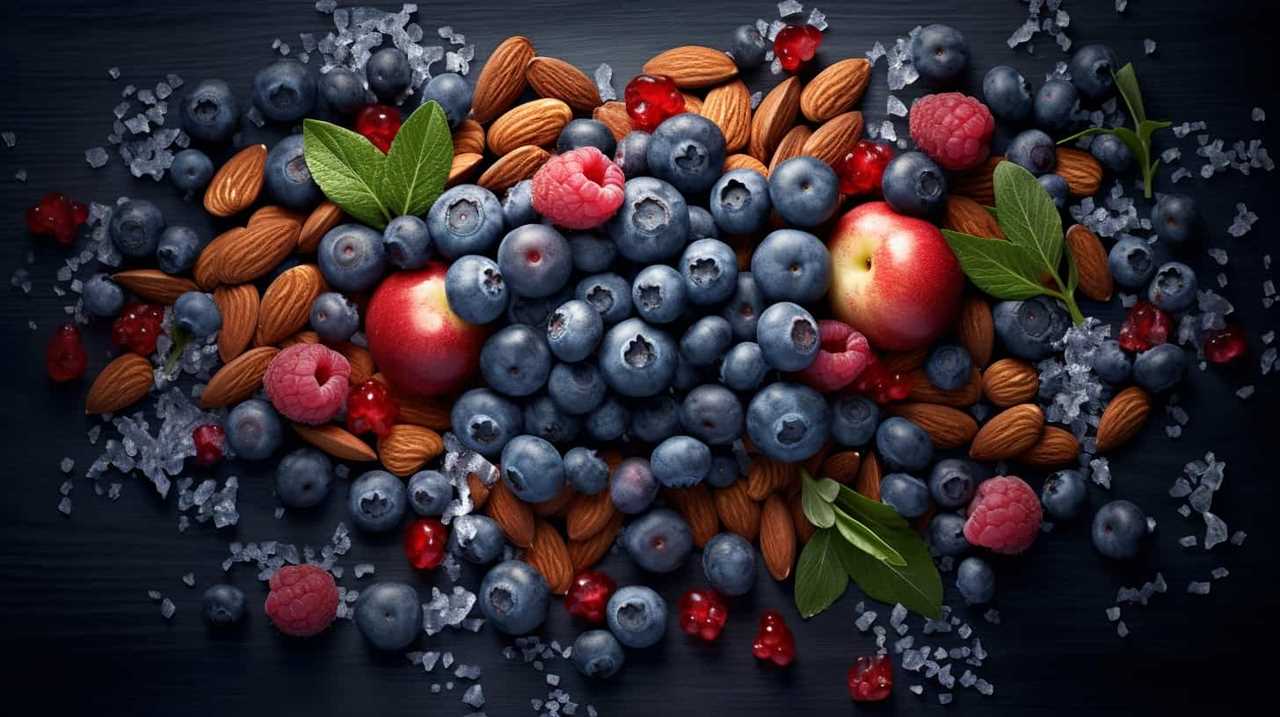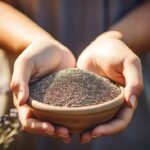Looking for ways to boost your chia seed farming business? Look no further! We bring you the top nine strategies that will revolutionize your agricultural practices.
From soil preparation to marketing strategies, we’ve got you covered. With our thorough and practical guide, you’ll learn how to select the right seeds, manage irrigation effectively, control pests and diseases, and so much more.
Get ready to elevate your chia seed farming game and experience the liberation of success!
Key Takeaways
- Thoroughly analyze soil composition and pH levels, implement crop rotation, and promote soil biodiversity for sustainable chia seed farming.
- Properly store and test seeds for high germination rates, and prioritize proper soil nutrient management for successful crop management.
- Implement effective pest and weed control strategies, such as crop rotation, mulching, and scouting for signs of infestation or disease.
- Ensure proper harvesting and processing techniques, including harvesting chia plants when seeds are fully mature and conducting rigorous quality control measures.
Soil Preparation
We typically begin commercial chia seed farming by thoroughly testing and analyzing the soil to determine the exact nutrient composition and pH levels required for optimal growth. Soil testing is an essential step in ensuring the success of our chia crops.

By understanding the nutrient composition of the soil, we can make informed decisions about fertilization and soil amendments, maximizing the yield and quality of our harvest. Additionally, we implement crop rotation strategies to maintain the health and fertility of the soil.
Crop rotation involves alternating the cultivation of chia with other crops to prevent the depletion of specific nutrients in the soil and reduce the risk of pests and diseases. This practice promotes soil biodiversity and sustainability, ultimately benefiting the long-term productivity of our chia fields.
Seed Selection
When it comes to commercial chia seed farming, seed selection plays a crucial role in determining the success of the crop.
Optimal seed traits, such as size, color, and oil content, should be carefully considered to ensure a high-quality harvest.

Additionally, selecting seeds with high germination rates is essential to maximize yield and minimize waste.
Optimal Seed Traits
To ensure the highest quality chia seeds for commercial farming, it’s essential to carefully select seeds with optimal traits. Here are some key factors to consider when choosing chia seeds:
- Seed Size: Select seeds that are uniform in size, as this ensures consistent germination and plant growth.
- Seed Color: Vibrant, dark-colored seeds indicate high nutritional content and are preferred in the market.
- Seed Purity: Ensure that the seeds are free from contaminants or other crop residues to maintain quality.
- Seed Viability: Conduct seed viability testing to determine the germination rate and select seeds with high viability.
- Optimal Seed Storage: Store the selected seeds in a cool, dry environment to preserve their viability and quality.
Ensuring High Germination
After carefully selecting chia seeds with optimal traits, we can now focus on ensuring high germination rates for our commercial chia seed farming operation. Improving yield and implementing proper storage techniques are key factors in achieving successful germination.
To ensure high germination rates, it is crucial to store chia seeds in a cool, dry place. Excessive heat and moisture can lead to decreased viability and germination rates. Additionally, regularly testing seed viability through germination tests can help identify any potential issues and allow for adjustments to be made.

Below is a table summarizing some effective storage techniques and their impact on germination rates:
| Storage Technique | Impact on Germination Rates |
|---|---|
| Cool and dry environment | High |
| Adequate air circulation | High |
| Properly sealed containers | High |
| Protection from pests | High |
| Regular seed viability tests | High |
Irrigation and Water Management
For successful commercial chia seed farming, proper irrigation and water management are essential. To ensure the optimal growth and yield of chia plants, consider the following irrigation and water conservation techniques:
- Drip irrigation systems: Utilize these efficient systems to provide water directly to the roots, reducing water wastage and promoting better water distribution.
- Mulching: Apply organic mulch around chia plants to reduce evaporation and soil moisture loss, helping to conserve water.
- Rainwater harvesting: Collect and store rainwater for irrigation purposes, reducing reliance on freshwater sources and conserving water.
- Monitoring soil moisture levels: Regularly check the moisture levels in the soil to ensure that chia plants receive adequate water without overwatering.
- Irrigation scheduling: Develop a proper irrigation schedule based on the specific needs of chia plants, taking into account factors such as weather conditions and plant growth stages.
Fertilization Techniques
When it comes to fertilization techniques for commercial chia seed farming, there are several key points to consider.
First, proper soil nutrient management is essential for the growth and development of healthy chia plants.

Second, organic fertilizers offer a sustainable and environmentally friendly option, ensuring the production of high-quality chia seeds.
Lastly, the timing of fertilizer application is crucial to maximize nutrient uptake and optimize plant growth.
Soil Nutrient Management
To maximize chia seed production, we prioritize efficient soil nutrient management techniques. Proper soil nutrient management is crucial for maintaining soil fertility and ensuring healthy chia plants. Here are some best practices for soil nutrient management:
- Crop Rotation: Implementing a crop rotation system helps prevent nutrient depletion and reduces the risk of diseases and pests. By rotating chia with other crops, we can optimize nutrient uptake and minimize soil nutrient imbalances.
- Soil Testing: Regular soil testing allows us to determine the nutrient levels and pH of the soil. Based on the test results, we can adjust our fertilization program accordingly, ensuring that chia plants receive the necessary nutrients for optimal growth.
- Organic Matter: Incorporating organic matter into the soil, such as compost or manure, enhances soil fertility and improves nutrient availability. This promotes healthy root development and nutrient uptake in chia plants.
- Balanced Fertilization: Applying fertilizers based on the specific nutrient requirements of chia helps maintain a balanced nutrient profile in the soil. This ensures that essential nutrients are available in the right amounts for optimal chia seed production.
- Timing and Application: Timing the application of fertilizers is crucial to maximize nutrient absorption by chia plants. Applying fertilizers during the active growth stages of the plants ensures efficient nutrient uptake and utilization.
Organic Fertilizers Options
To ensure optimal nutrient availability and promote sustainable chia seed production, we incorporate various organic fertilizer options and employ effective fertilization techniques.

Organic fertilizers are derived from natural sources such as plant and animal materials, and they provide essential nutrients to the soil in a slow-release manner, ensuring long-term soil health. By using organic fertilizers, we reduce the risk of chemical runoff and contamination, thereby protecting the environment and promoting natural pest control.
Some popular organic fertilizer options include compost, manure, bone meal, and seaweed extracts. These fertilizers not only supply nutrients to the chia plants but also improve soil structure and fertility.
Incorporating sustainable farming methods, such as organic fertilization, contributes to the overall health of the ecosystem and supports long-term chia seed production.
As we move forward, it’s essential to consider the timing of fertilizer application to maximize its effectiveness and minimize environmental impact.

Timing of Application
We prioritize the strategic timing of fertilizer application to optimize nutrient absorption and minimize environmental impact in our commercial chia seed farming practices. Proper timing of fertilizer application is crucial for the healthy growth and development of chia plants.
Here are some best practices to consider:
- Best time for application: Apply fertilizers before sowing the chia seeds to ensure the nutrients are readily available for the young plants during their critical growth stages.
- Sowing technique: Incorporate the fertilizers into the soil during sowing to ensure even distribution and maximum nutrient uptake by the chia plants.
- Split application: Consider dividing the total fertilizer requirement into multiple applications throughout the growing season to provide a continuous supply of nutrients to the chia plants.
- Crop stage specific: Adjust the timing of fertilizer application based on the different growth stages of chia plants, such as during germination, vegetative growth, flowering, and seed development.
- Environmental conditions: Take into account factors like weather conditions, soil moisture, and temperature when determining the timing of fertilizer application to optimize nutrient availability and minimize losses.
Weed Control
One important aspect of our commercial chia seed farming practices is maintaining effective weed control. We believe in integrating pest management strategies that prioritize sustainable weed control methods. By implementing these practices, we not only ensure the health and productivity of our chia plants but also contribute to the liberation of our environment from harmful chemical pesticides.
To demonstrate our commitment to sustainable weed control, we’ve developed a comprehensive table outlining the different techniques we employ. This table showcases the various methods we use, such as crop rotation, mulching, hand weeding, and mechanical cultivation. Each technique is carefully selected and employed at the appropriate stage of our chia crop’s growth cycle, ensuring maximum effectiveness.

Through these integrated practices, we’re able to maintain a weed-free chia seed farm while preserving the natural balance of our ecosystem.
Pest and Disease Management
Our commitment to sustainable weed control extends to the effective management of pests and diseases in our commercial chia seed farming practices. Integrated pest management is a crucial approach that we employ to minimize the use of chemical pesticides while maintaining healthy chia crops.
Here are five key practices we implement for pest and disease management:
- Crop rotation: We rotate chia with other crops to break the lifecycle of pests and reduce the risk of disease buildup.
- Biological control: We introduce beneficial insects and organisms that naturally prey on pests, such as ladybugs and predatory mites.
- Monitoring and scouting: Regular monitoring helps us identify early signs of pest infestation or disease, allowing for timely intervention.
- Cultural practices: We implement proper irrigation, fertilization, and pruning techniques to promote plant health and resilience against pests and diseases.
- Resistant varieties: We select chia varieties that have natural resistance to common pests and diseases, reducing the need for chemical interventions.
Harvesting and Processing Methods
To ensure optimal quality and efficiency in our chia seed farming practices, it’s important to implement effective harvesting and processing methods.

Harvesting techniques play a crucial role in determining the quality of the chia seeds. It’s recommended to harvest the plants when the seeds are fully mature, which is typically indicated by the drying and splitting of the seed heads. This can be done through mechanical harvesting or by hand.
Once the chia plants are harvested, it’s essential to properly process the seeds to remove any impurities. Post-harvest processing involves cleaning the seeds, removing any debris, and drying them thoroughly to prevent mold or spoilage. Additionally, the seeds can be further processed through a cleaning machine to ensure uniformity in size and shape.
Implementing these harvesting and processing methods will result in high-quality chia seeds that meet the expectations of our liberated audience.
Quality Control Measures
After harvesting and processing the chia seeds, we implement rigorous quality control measures to ensure our final product meets the highest standards.

Our commitment to quality begins with proper seed storage. We store the chia seeds in a cool, dry place to maintain their freshness and prevent spoilage.
Post-harvest handling is another crucial aspect of our quality control process. We carefully inspect the seeds for any signs of damage or contamination before packaging them. Additionally, we conduct regular tests to check for any presence of foreign matter or impurities.
To maintain the nutritional integrity of the chia seeds, we prioritize quick and efficient processing methods.
Marketing and Distribution Strategies
Once the chia seeds have undergone rigorous quality control measures, we can now focus on implementing effective marketing and distribution strategies.

Marketing strategies play a crucial role in promoting chia seeds and creating a demand in the market. We should start by identifying our target audience and understanding their needs and preferences. This will help us tailor our marketing messages to resonate with them. Utilizing digital platforms, such as social media and email marketing, can be an efficient way to reach a wide audience. Additionally, collaborating with health and wellness influencers can help generate brand awareness and credibility.
Distribution techniques are equally important in ensuring that chia seeds reach the intended consumers. We should consider partnering with local grocery stores, health food stores, and online retailers to make our products easily accessible. Building a strong distribution network will help us meet the demand efficiently and maintain a competitive edge in the market.
Conclusion
In conclusion, by following these 9 best practices for commercial chia seed farming, farmers can ensure a successful and profitable venture.
- Proper soil preparation
- Seed selection
- Irrigation
- Fertilization
- Weed control
- Pest and disease management
- Harvesting and processing methods
- Quality control measures
- Effective marketing and distribution strategies
By implementing these techniques, farmers can maximize their yields and deliver high-quality chia seeds to the market.

By meeting the growing demand for this nutritious and versatile crop, farmers can successfully capitalize on the opportunities presented by the chia seed industry.
Happy chia farming!
















